Exhibition place:Textile Conservation Gallery
Exhibition time:2019.12 - 2020.5
INTRODUCTION:
Before humans roamed the earth, plants were already in place. Our ancestors relied on nature for their daily survival, and this relationship built civilisation. Leaves and twigs were made into temporary baskets to carry hunted and gathered foods. Plant materials were manipulated to make items such as mats, roofs, and walls for shelter. Eventually, plant fibres were extracted and processed into yarns, then woven into cloth to clothe us, giving birth to textile culture.
The hat collection gives us an excellent opportunity to review how plant resources around us affect our lives. Today, in a world over-supplied with colourful manufactured items, these hats, made of perishable materials, might look primitive and outdated. Through these humble hats, let us ponder again, how humans take reference from nature, and how our evolution depends on working with nature.
We have chosen sixty-six items from Barbara's collection to highlight their provenance, materials, craft techniques and cultural stores. Paired with maps, travel souvenirs, diagrams and material samples, we hope this exhibition is colourfully light-hearted and, at the same time, educational.
ABOUT THE DONOR
The Barbara Park Asian Hat Collection of 128 items was donated to the China National Silk Museum in 2016, to enable in-depth study of crafts and appreciation of the diversity of the natural world and cultures in the region.
Barbara is an Australian entrepreneur who has lived and worked in Hong Kong for over fifty years. Her parents and grandparents have all been keen gardeners and craftspeople, so her appreciation of nature is firmly in her blood. Her favourite colour is green. For twenty-five years she had a landscaping business throughout Asia, during which the collection of hats was amassed. She also collects a variety of Asian crafts including porcelain, wood carvings, baskets and textiles.
She is a Life Member of many cultural associations, including the Hong Kong Museum of Art, the Friends of the Museum, Chinese University, the Friends of the Hong Kong University Museum, The Oriental Ceramic Society of Hong Kong and the Hong Kong Gardening Society. So many handcrafts are disappearing in Barbara's lifetime that she felt dutybound to collect and is delighted that the hats can be shared with so many visitors from Hangzhou, China, and visitors from around the world.
I、Lands
Barbara has travelled extensively in Asia, sometimes for work, other times for vacation and cultural study trips. She is always looking out for a different hat. From hats chosen to represent eleven countries, we can see both the diversity and similarity in materials, techniques, and usage, which were often results of exchange through trading over centuries.
China
Based in Hong Kong for over forty years, Barbara has made many trips to China, frequently collecting a new hat from a different part of China. The wide variety of forms, materials, and techniques tells of the vast natural and craft resources available.
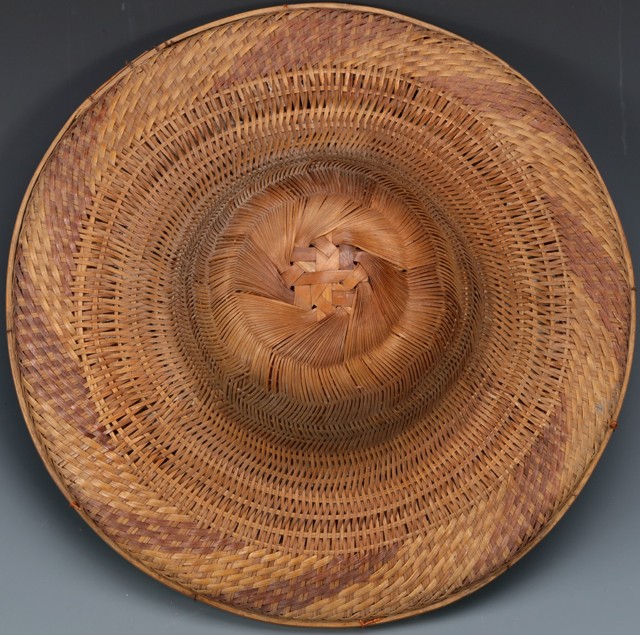
Two colour split bamboo hat with fancy plaiting
Southwest China
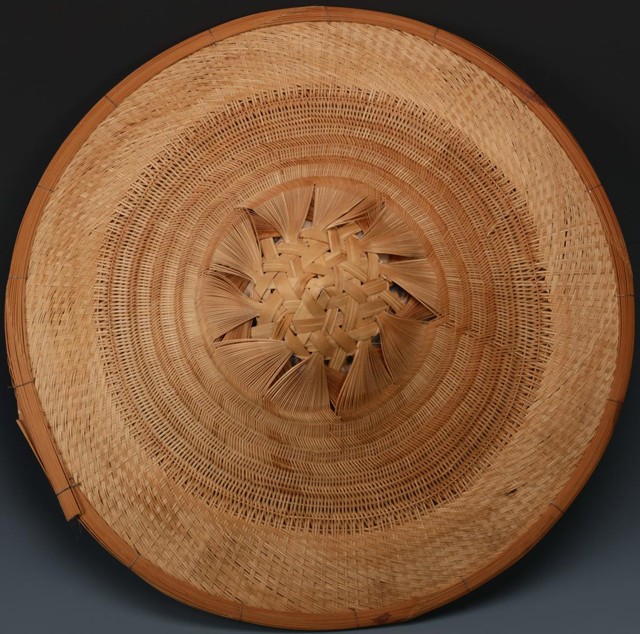
Split bamboo hat with fancy plaiting
Yunnan, China
Malaysia
Malaysia has a multi-ethnic, multi-cultural, and multi-lingual society. Within the Malaysian community, there is a Malay culture, a Chinese culture, an Indian culture, a Eurasian culture, along with the cultures of the indigenous groups of the peninsula and north Borneo. Other cultural influences came from trading on the sea route which includes Persian, Arabic, and British cultures.
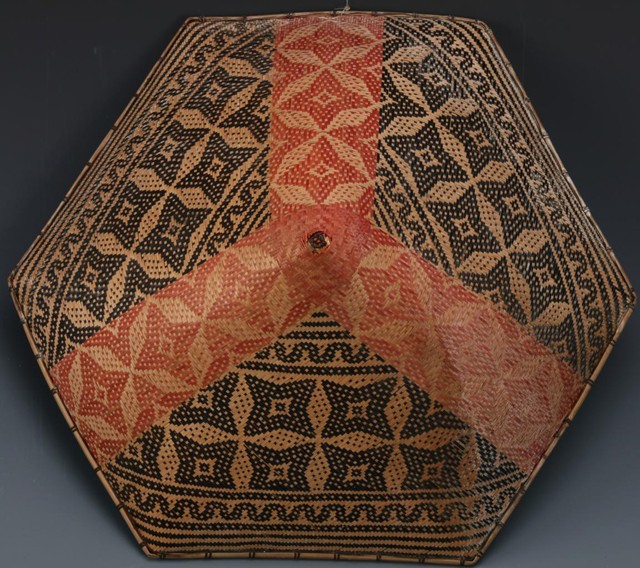
Hexagon shaped plaited hat with 3-colour patterning
Malaysia
Thailand
Thailand is one of the most popular tourist destinations for those seeking a tropical holiday experience. Rich Khmer culture, abundant with flora and fauna, created a friendly culture and economy. The Floating Market in Bangkok is a must-see, with the iconic flat-top Ngob hat. The high top allows air to circulate between the hat and the head, a design to keep the head cool.

Flat top hat, Ngob, made of leaves from talipot palm
Thailand
Vietnam
Vietnam is bordered by China, Laos, Cambodia, Thailand across the Gulf of Thailand and the Philippines, Malaysia, and Indonesia across the South China Sea.
Over centuries, Chinese influences Vietnamese culture in terms of Confucian ideology, governance, and the arts. Following independence from China in the 10th century, successive Vietnamese imperial dynasties flourished as the country embarked on a southward expansion that absorbed territories of the Champa and Khmer civilisations, which resulted in regional variances of modern-day Vietnamese culture.
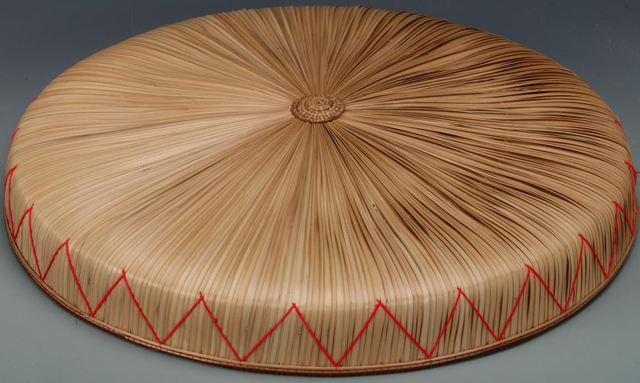
Tonkin style palm leaf flat hat
Vietnam
The Ba tam is a traditional Vietnamese flat palm leaf hat, it was worn by women in North Vietnam’s Tokin region, as an accessory to finer garments. The hat, when worn by mediums, traditionally had silver ornaments hanging from silk strings around the brim.
Cambodia
Cambodia is mostly a land of plains and great rivers and lies amid important overland and river trade routes linking China to India and Southeast Asia.
Angkor Wat, the legendary temple complex in Siam Reap, is the reason to visit Cambodia. The priced Chinese Dain Cui Kingfisher feather jewellery used a species of Kingfisher bird from Cambodia. The trade of these precious feathers may have been a major contributor to the wealth of the Khmer Empire and used to help fund the construction of the magnificent temple complex. One of the best accounts of Cambodia is The Customs of Cambodia, written by a Chinese diplomat Zhou Daguan during the Yuan Dynasty in the late 13th century.
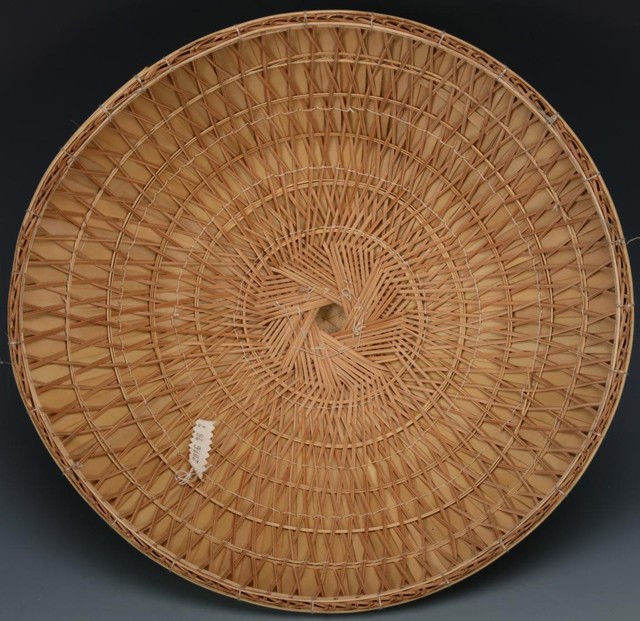
Dome-shaped farmer hat with overlapping palm leaves.
Cambodia
II. Flora.
We are part of nature: its biodiversity provides us with resources that build our livelihood. Plants in different lands and climate grow in various forms and heights, and each species developed its exceptional character. Leaves, vines, and grasses inspired endless possibilities to make a hat.
The palm tree is the iconic plant of the tropics, belonging to the perennial botanical family of Arecaceae. Fifty-three million years ago, Antarctica was so warm that palm trees lived along its shores. Currently, 181 genera with around 2600 species are known. Of the eleven plant materials chosen to here, five of them belong to the Palm family.
Bamboo
Bamboo (Bambusoideae) of the grass family (Poaceae) include some of the fastest-growing plants in the world; certain species of bamboo can grow 900 mm within 24 hours. There are more than 1,400 species of bamboo, placed in 115 genera.
Bamboo plays an integral part in Chinese culture, both economically and culturally. Before the invention of paper, ancient China first wrote their text on bamboo stripes, and the writing brushes have a bamboo shaft to hold the hairs. Bamboo is omnipresent in China because of its availability, lightness, strength and flexibility. Buildings, musical instruments, weapons, farm tools, and cooking utensils. Papermaking uses pulp from bamboo, and the modern textile industry make bamboo rayon by dissolving the cellulose in the bamboo and then extruded to form fibres.
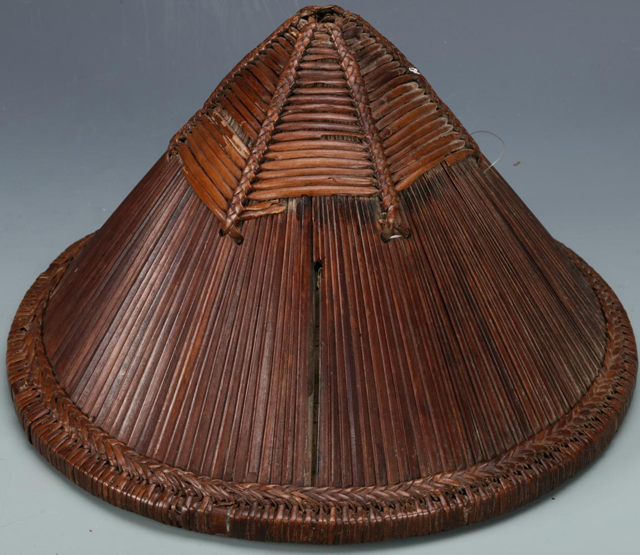
Bamboo helmet of foot soldier from the Late Qing Dynasty
China
Buri Palm ( Corypha umbraculifera)
In the Philippines, leaves of the Buri Palm are for thatching, and the sap is tapped to make palm wine. The strong ribs of the leaves are used to make brooms and brushes. The seeds are polished, sometimes dyed and cut into beads as accessories. Fine, soft fibres from the petioles of the Buri Palm are plaited into the famous Buntal hats which compares to the elegant Panama hat.
In various Southeast Asian cultures, palm leaf manuscripts are made by using an iron stylus on the leaf. In South India, the traditional olakkuda umbrella is made with palm leaves and bamboo.

Buri Palm rib plaited hat with a 6-pointed star
Philippines
Coconut Palm (Cocos nucifera)
The coconut palm is known as the “Tree of Life” in the Philippines. The fruit provides juice and flesh for food, coir fibres used for ropes and mats, and the shell is a natural container. The leaves grow in the pinnate form, which is convenient to be interlaced circularly to become an instant hat or basket.
This hat was from Barbara’s 1978 scuba diving trip to the Philippines, these hats made of fresh leaves are often presented to the visitors as welcome gift and a reminder to shade oneself from the intense sun.
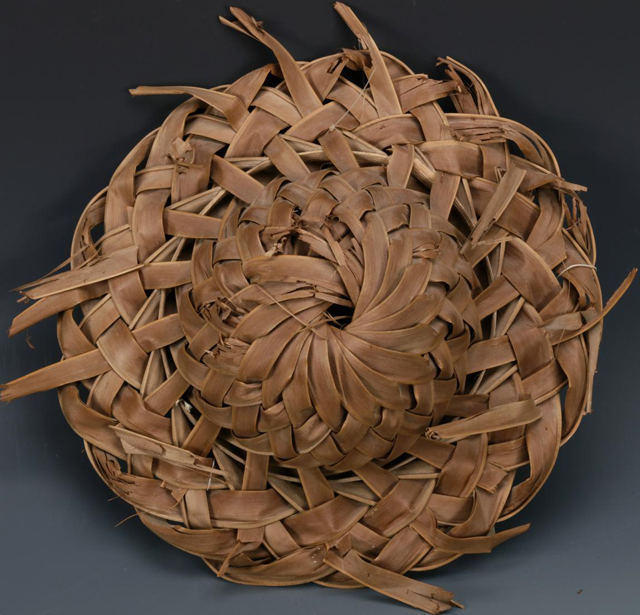
Coconut Leaf frond plaited hat
The Philippines
Pandan leaf (Pandanus)
Pandanus is often mistaken as a palm, and it belongs a genus of monocots with some 750 species. They are dioecious trees and shrubs native to the tropics and subtropics.
For handicrafts, Pandanus leaves are collected from the wild, cutting only mature leaves so that the plant will naturally regenerate. The leaves are sliced into strips of standard width for plaiting. They can be easily dyed into bright colours, and plaited into mats and bags.
Pandan leaves from Pandanus amaryllifolius are used widely in Southeast Asian and South Asian cuisines to add a distinct aroma to various dishes: Curries, sweets and drinks.
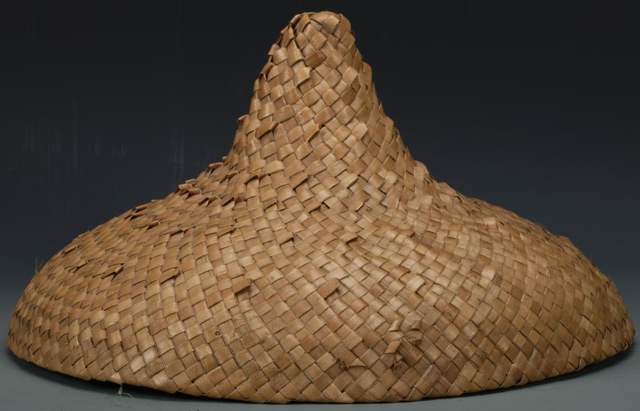
Pandanus leaves plaited pointed hat
Philippines
Ⅲ.Fabrication
How do you make a hat? Where is the origin of the techniques? Nature provided us with precious materials and ideas, by studying the natural growth of plants at different seasons, our ancestors imagined how things might work. Plants are pliable when fresh, become hard when dried. Fibres are tangled and layered in the trunk, and vines intertwined itself into a net. Over time, these observations developed into know-how and techniques. Through trading and communications, these craft techniques travelled and exchanged, with some being universal.
The chosen material is paired up with techniques that will create a comfortable hat that serves its purpose: may it be protection from the sun and rain and falling objects or its decorative use.
Bamboo split
Bamboo can be split into various thickness according to its application. This unusual unfinished hat kept the whole original bamboo as its finial, then the Stake and Strand technique is used to secure its form. Extra leaves and lining would have been added on the underside to complete the hat.
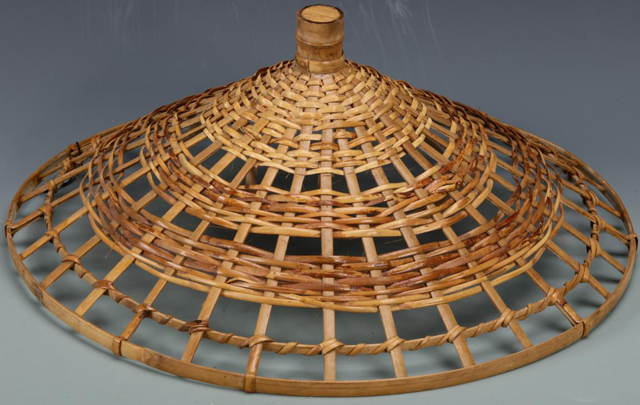
Unfinished hat made of one piece of split bamboo
The Philippines
Biaxial Plaiting
Though the finished effect resembles a woven cloth, the term “plaited “ is used as opposed to “woven”. In fabric making, the warp is stretched on a frame and remain stable, with the weft as the moving element. In plaiting, both parts are moving together, as in making a hair braid. This technique has much structural plasticity, so a lot of forms are possible.
Like weaving, plaited patterns are created according to the interlacing pattern ( plain, twill, herringbone), coloured materials provide another dimension.
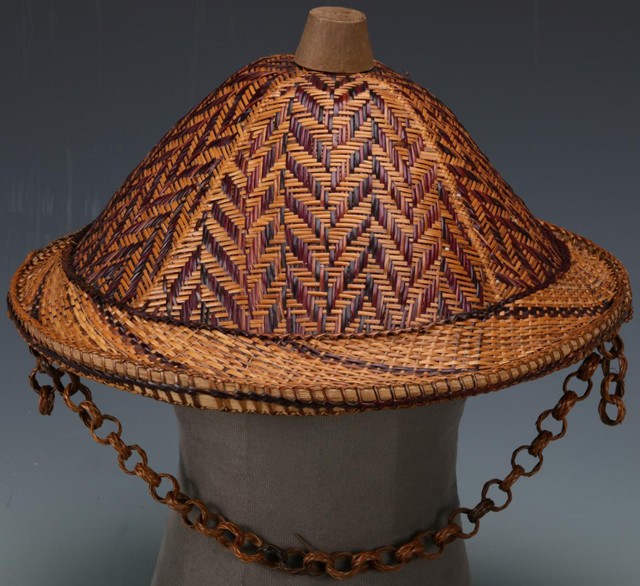
Biaxial Plaited hat with Herringbone pattern and chain as a chin strap,
Worn by the Yakan and Tausug people in Mindanao, the Philippines
Stake and Twisted strand
This hat is a variation of the Stake and strand technique; the strand used has a width that will not lay flat while weaving the circular form. To make it work, strands work in pairs; twisted along each other to create an unusual texture while curving along with the circular shape.
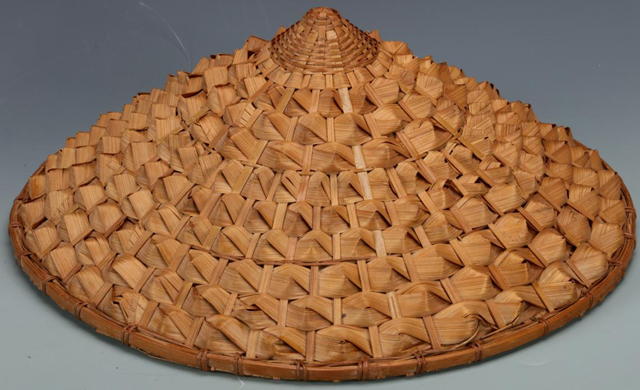
Stake and Twisted strand conical hat
Hong Kong, China
Hexagonal plaiting/ triaxial plaiting
The maker interlaces three strips to create a surface that forms hexagonal patterns; hence both “triaxial plaiting” and “ hexagonal plaiting” is often used to describe this technique. Plaiting with three axes have four times the tear resistance of biaxial construction, and resist spreading (runs). Plaiting can make tight or with open spaces. As an open weave, it is an economical use of materials to produce a lightweight yet sturdy container, especially for transporting livestock and agriculture products that require ventilation to stay fresh.
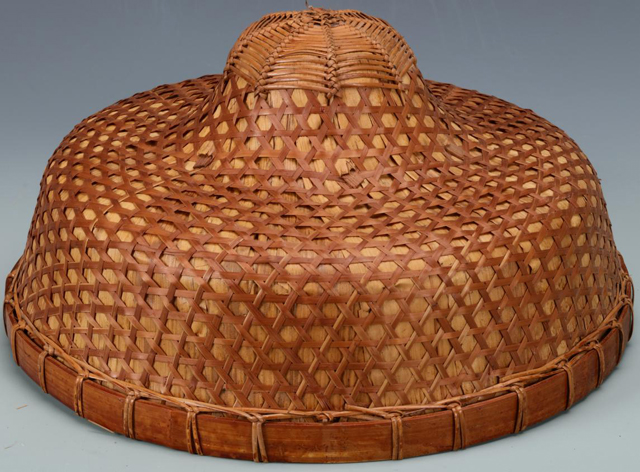
Classic Open Triaxial plaited hat for Hong Kong’s boat people
Hong Kong, China
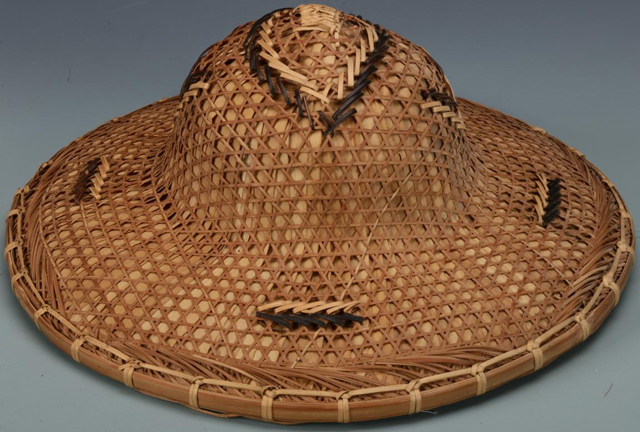
Open Triaxial plaited hat with decorated details
The Philippines
Plaited Frond
Palms have large, evergreen leaves that are either palmately ('fan-leaved') or pinnately ('feather-leaved') compound and spirally arranged at the top of the stem.
Pinnate fronds, like the coconut, gave birth to this method. The pinnate leaflets, grow from both sides of a rachis to become a frond. The frond is split along the rachis into two halves, and this is cut to the desired length and bound into a circle. The leaflets naturally become a radial arrangement where they can be interlaced to form a hat or basket. The tapering leaf blade becomes a natural fringe.
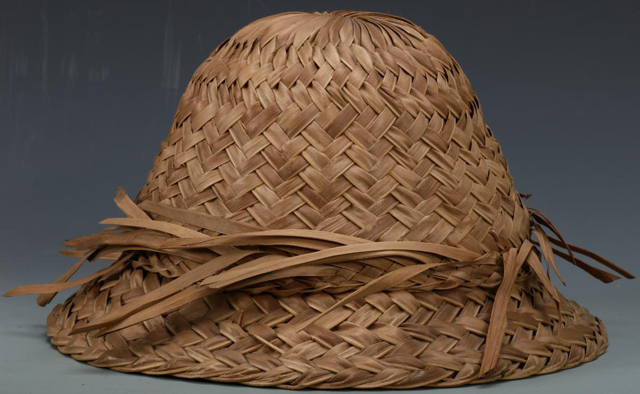
Palm frond plaited hat
The Philippines
IV. STORIES
Once a hat is put on a body, it gains an identity. It becomes a symbolic representation of a tribe or community, identifying one’s profession and social status. Hats in this group lead us to diversified cultures and enable us to see that what might have started as a hat for practicality becomes an extraordinary storyteller.
Sulawesi Toraja hat
In Barbara’s notes, this hat was acquired from an antique shop in Bali and is a “Torajan Headman’s hat”. We found little information on this hat during the research; the only photo information that surfaced relate the hat to the unusual funeral ritual of the Torajans.
The Torajans are an ethnic group indigenous to a mountainous region of South Sulawesi, Indonesia. They are renowned for their elaborate funeral rites, burial sites carved into rocky cliffs, massive peaked-roof traditional houses known as tongkonan, and colourful wood carvings.
Toraja funeral rites are important social events, usually attended by hundreds of people and lasting for several days, with songs and dances, water buffalo fights and sacrifices. Mile-long processions move through a village, and finally, the coffin will be placed on the cliff, with an effigy displayed outside.
A highly detailed carved effigy of the deceased is created as a part of the traditional funeral practice for viewing and procession, and here we see a hat identical to Barbara’s is here. Whether this hat is explicitly made for this occasion is not known, as in other photos of the funeral, different types of hats are seen.

Toraja hat with hexagonal decorations
Sulawesi, Indonesia
Gourd hat
The Tabungaw gourd hat is made from a big round gourd that is unique to the Philippines, which are part of the Cucurbitaceae family. Teofilo Garcia, a gourd hat maker, was named the National Living Treasure Awardee in 2012.
He plants his seeds in December, and harvest the crop in March. The gourds are left in the workshop to be cured and dried, then cut into two halves and left on the ground for about a month. Ants attracted to the rotting pulp will remove the insides, leaving the case empty. It is then finished by hand and left to dry completely.
The upper half of the gourd is used to make the Tabungaw. The bottom half becomes a container used around the house. After drying, the Tabungaw is naturally waterproof, then coloured and varnished.
The most time consuming and skillful part is the weaving of inner casing and lining which makes the hat sits comfortably on the user’s head. The interior lining is plaited with palm leaves, bamboo, or rattan. It takes an average of seven days to complete a hat which will last a lifetime if taken care of properly.

Gourd Hat with painted flower
The Philippines
Bali Duck Herder’s hat
During the monsoon season in Bali, intervals of intense sun and heavy showers fill a single day. Nicknamed as the Duck herders hat, these huge hats are made from sturdy palm sheaths and said to also double as a container for collecting duck eggs. Ducks are for hire to go to paddy fields, their mission is to guard crops against insect attacks, eat up the weeds, and leave their manure behind as organic plant food. This technique, known as integrated rice-duck farming, was documented in China some 600 years ago.
When we look at old photographs, hats used to be of these bigger sizes, like an umbrella, adequately protecting the wearer’s body from sun and rain. Today, hats are smaller, probably because of having to ride on public transportation and the availability of rain capes.
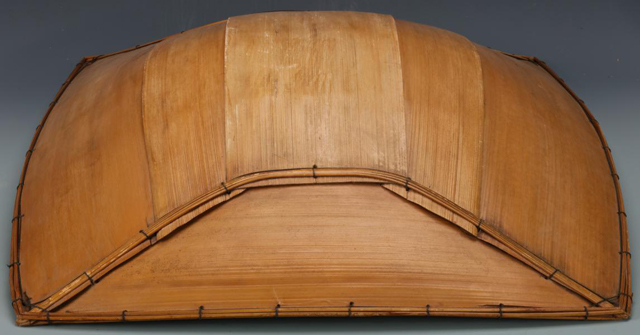
Square-shape duck farmer hat made of Palm Sheath
Bali, Indonesia
Gaddang Tribe style hat
This highly decorative hat was purchased in the 1990s, from an antique gallery in Manila. It comes with a tag that states it is from the Gaddang tribe, made of buri palm, rattan and beads. The Gaddang people live in North Luzon, the Philippines, and their costumes display exquisite beadworks. We were not able to find any information relating the hat to the Gaddang people, whether the item is part of their culture or made solely for trade. We found commercial knit cloth on the hat, an indication of communication with the outside world.
In the early 17th century, the arrival of the Spanish missionary to the Philippines created the distinction between the "Christianized" and "non-Christian" Gaddang. The successive influence through American occupation and Japanese occupation all has its impacts on the culture of the Gaddang people.

Gaddang tribe style hat, made with Buri palm, beads, knit cloth,
the Philippines
Hat with many peaks
Is this a traditional style or just another style for the tourist market? Unable to retrieve any further information, we looked around at other traditional Asian hats and found the “topi tunjang’ headdress of the Iban tribe in the Island of Borneo, Sarawak, Malaysia.
The hat is quite an intricate craft: Plaiting to create protruding peaks, while creating a pattern with the two colour strips. The basketry skills in the region are very sophisticated, Baskets and sacs made often features similar patterns.
Mr Edric Ong of Sarawak, Malaysia is an acclaimed international curator, artist, designer and promotor on crafts, especially on ethnic textiles of Sarawak. Over the years, he has developed the Iban man’s ‘topi tunjang’ rattan hat into a fashion item, which he features in his catwalks.
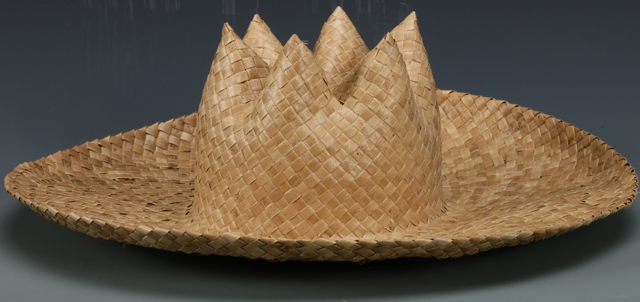
Pandanus leaf plaited hat with Six Peaks
Philippines
Myanmar Thayo hat
Myanmar is famous for its lacquer work with many regional techniques. The Thayo technique is a relief-molded technique which involves preparing a fine lacquer and ash paste that is rolled into long threads and applied to a surface to form raised decorations. This technique used on the bamboo sheath hats for ornamentation, we can see the Burmese horoscope animals, the boatman of Inle lake and vine pattern made with this technique.
In the Inle Lake region, every year in October, an 18-day Hpaung Daw U Pagoda festival is held. Buddha images are put on replica Royal Barge boats to tour the area, and boat races attract a lot of visitors. These highly decorative hats are worn on this occasion and exchanged as gifts or sold to tourists.

Bamboo Sheath hat with relief decorative pattern
Inle Lake, Myanmar
 Pay attention to us
×
Pay attention to us
×